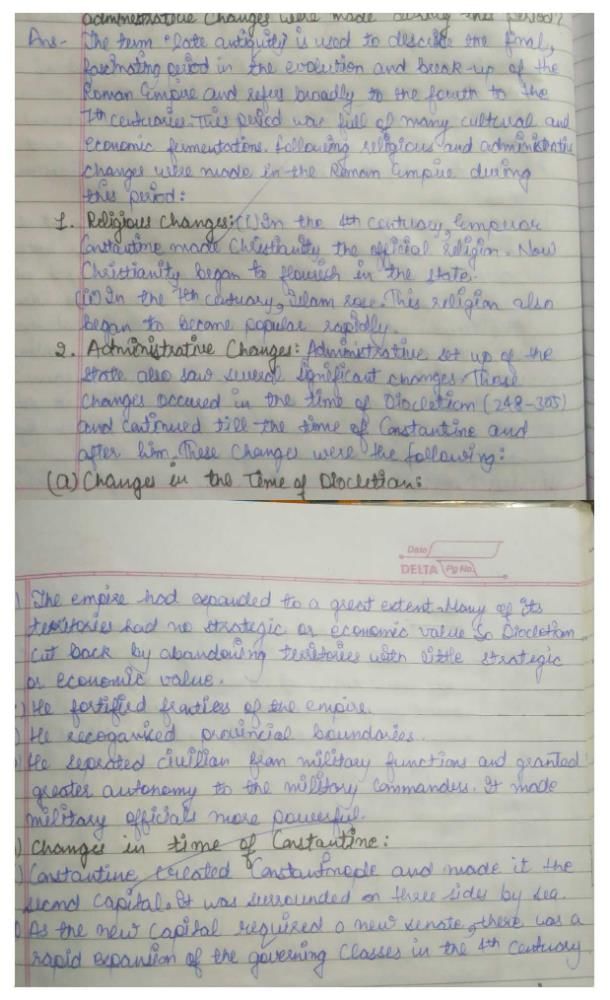Humanities/Arts Exam > Humanities/Arts Questions > What is meant by 'late antiquity'? Which reli...
Start Learning for Free
What is meant by 'late antiquity'? Which religious and administrative changes were made during this period?
Most Upvoted Answer
What is meant by 'late antiquity'? Which religious and administrative ...

Community Answer
What is meant by 'late antiquity'? Which religious and administrative ...
Late Antiquity refers to the period between the 3rd and 8th centuries AD, characterized by significant religious, cultural, and administrative changes. During this time, the Roman Empire underwent a transformation that led to the emergence of a new social, political, and religious order.
Religious Changes:
1. Emergence of Christianity: Christianity became the dominant religion during this period, replacing paganism, which was the primary religion of the Roman Empire.
2. Rise of Monasticism: Monasticism emerged as a significant religious movement during this period, with monks and nuns living in isolation from the world to devote their lives to prayer and meditation.
3. Development of Church Hierarchy: The Church hierarchy developed during this period, with the establishment of a patriarchal system of bishops, archbishops, and popes.
Administrative Changes:
1. Division of the Roman Empire: The Roman Empire was divided into two, with the Western Roman Empire collapsing, and the Eastern Roman Empire (Byzantine Empire) continuing to thrive.
2. Emergence of Feudalism: Feudalism emerged as a new social and economic system, with feudal lords controlling the lands and the peasants working on them.
3. Development of the Byzantine Empire: The Byzantine Empire emerged as a significant power during this period, with Constantinople becoming the new capital of the Roman Empire.
Conclusion:
Late Antiquity was a period of significant changes, marked by the emergence of a new social, political, and religious order. The rise of Christianity, monasticism, and the Church hierarchy, the division of the Roman Empire, the emergence of feudalism, and the development of the Byzantine Empire were some of the significant changes that took place during this period.
Religious Changes:
1. Emergence of Christianity: Christianity became the dominant religion during this period, replacing paganism, which was the primary religion of the Roman Empire.
2. Rise of Monasticism: Monasticism emerged as a significant religious movement during this period, with monks and nuns living in isolation from the world to devote their lives to prayer and meditation.
3. Development of Church Hierarchy: The Church hierarchy developed during this period, with the establishment of a patriarchal system of bishops, archbishops, and popes.
Administrative Changes:
1. Division of the Roman Empire: The Roman Empire was divided into two, with the Western Roman Empire collapsing, and the Eastern Roman Empire (Byzantine Empire) continuing to thrive.
2. Emergence of Feudalism: Feudalism emerged as a new social and economic system, with feudal lords controlling the lands and the peasants working on them.
3. Development of the Byzantine Empire: The Byzantine Empire emerged as a significant power during this period, with Constantinople becoming the new capital of the Roman Empire.
Conclusion:
Late Antiquity was a period of significant changes, marked by the emergence of a new social, political, and religious order. The rise of Christianity, monasticism, and the Church hierarchy, the division of the Roman Empire, the emergence of feudalism, and the development of the Byzantine Empire were some of the significant changes that took place during this period.

|
Explore Courses for Humanities/Arts exam
|

|
Similar Humanities/Arts Doubts
What is meant by 'late antiquity'? Which religious and administrative changes were made during this period?
Question Description
What is meant by 'late antiquity'? Which religious and administrative changes were made during this period? for Humanities/Arts 2025 is part of Humanities/Arts preparation. The Question and answers have been prepared according to the Humanities/Arts exam syllabus. Information about What is meant by 'late antiquity'? Which religious and administrative changes were made during this period? covers all topics & solutions for Humanities/Arts 2025 Exam. Find important definitions, questions, meanings, examples, exercises and tests below for What is meant by 'late antiquity'? Which religious and administrative changes were made during this period?.
What is meant by 'late antiquity'? Which religious and administrative changes were made during this period? for Humanities/Arts 2025 is part of Humanities/Arts preparation. The Question and answers have been prepared according to the Humanities/Arts exam syllabus. Information about What is meant by 'late antiquity'? Which religious and administrative changes were made during this period? covers all topics & solutions for Humanities/Arts 2025 Exam. Find important definitions, questions, meanings, examples, exercises and tests below for What is meant by 'late antiquity'? Which religious and administrative changes were made during this period?.
Solutions for What is meant by 'late antiquity'? Which religious and administrative changes were made during this period? in English & in Hindi are available as part of our courses for Humanities/Arts.
Download more important topics, notes, lectures and mock test series for Humanities/Arts Exam by signing up for free.
Here you can find the meaning of What is meant by 'late antiquity'? Which religious and administrative changes were made during this period? defined & explained in the simplest way possible. Besides giving the explanation of
What is meant by 'late antiquity'? Which religious and administrative changes were made during this period?, a detailed solution for What is meant by 'late antiquity'? Which religious and administrative changes were made during this period? has been provided alongside types of What is meant by 'late antiquity'? Which religious and administrative changes were made during this period? theory, EduRev gives you an
ample number of questions to practice What is meant by 'late antiquity'? Which religious and administrative changes were made during this period? tests, examples and also practice Humanities/Arts tests.

|
Explore Courses for Humanities/Arts exam
|

|
Signup for Free!
Signup to see your scores go up within 7 days! Learn & Practice with 1000+ FREE Notes, Videos & Tests.
























